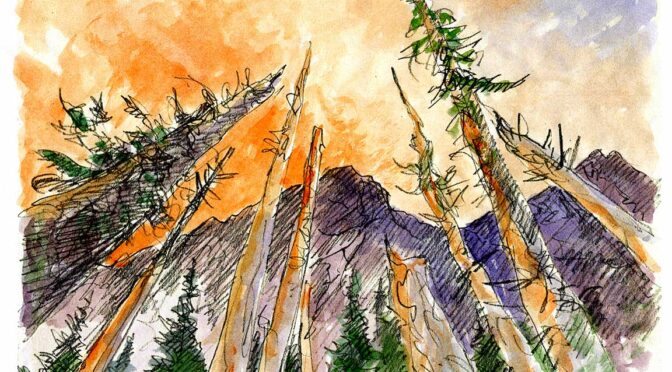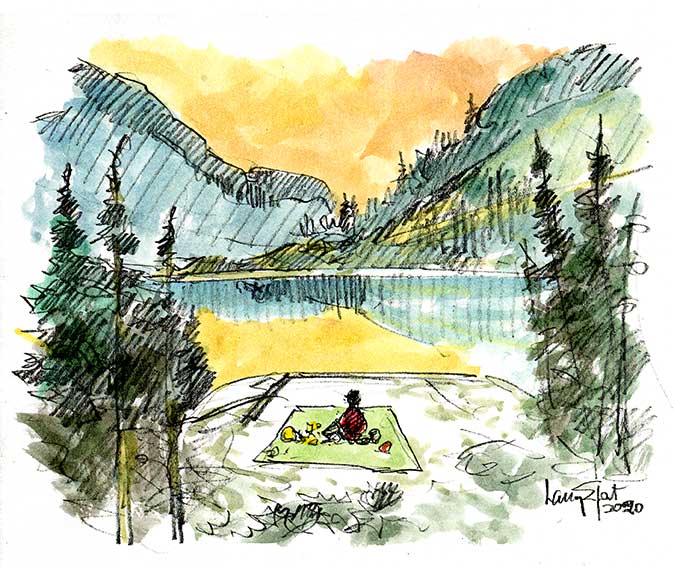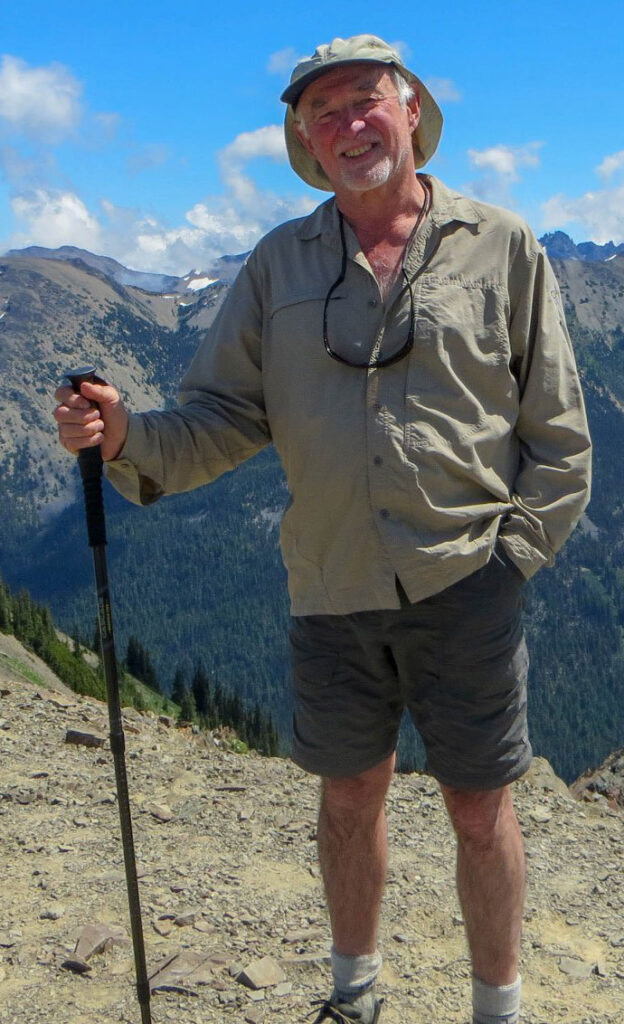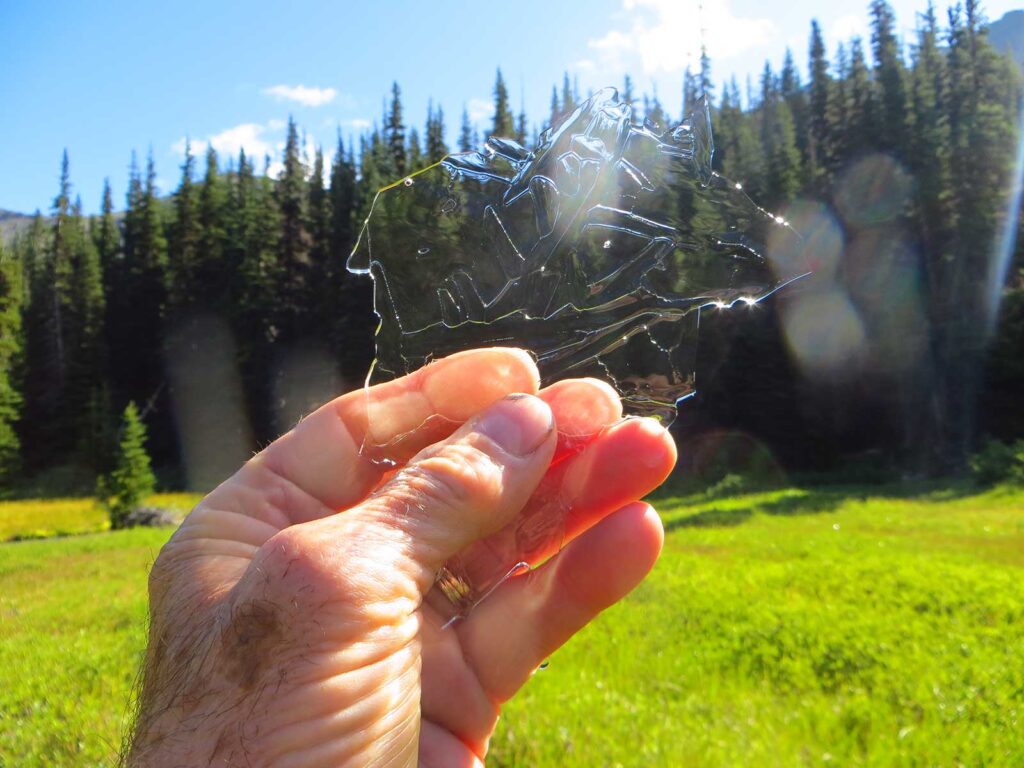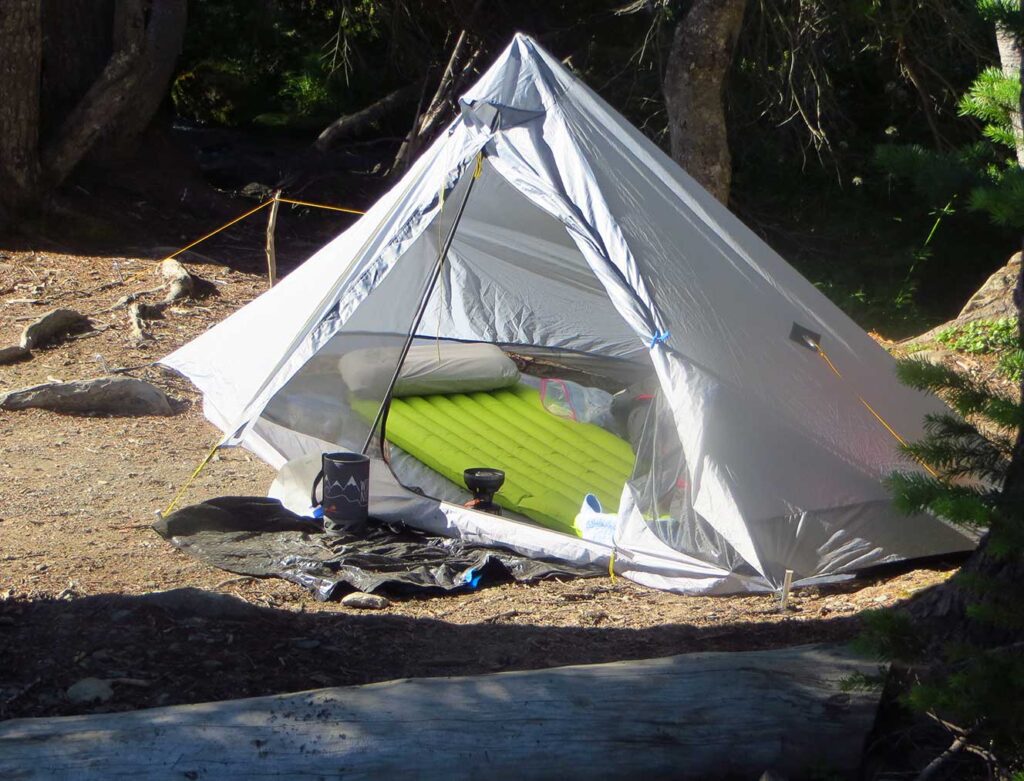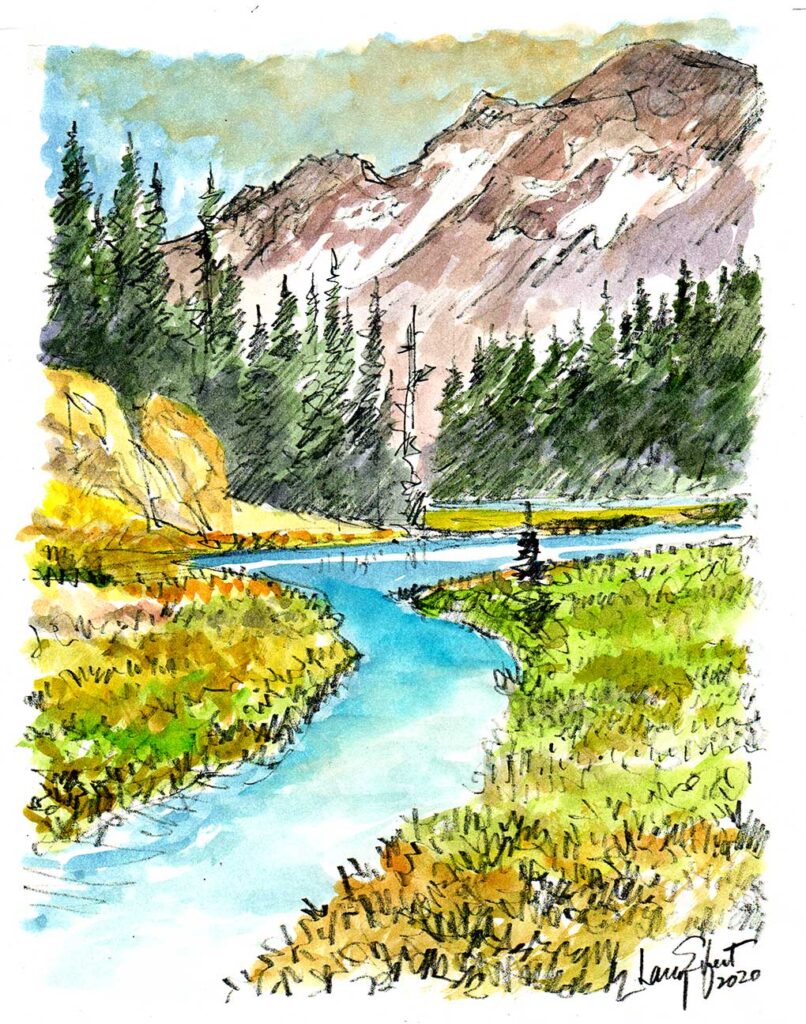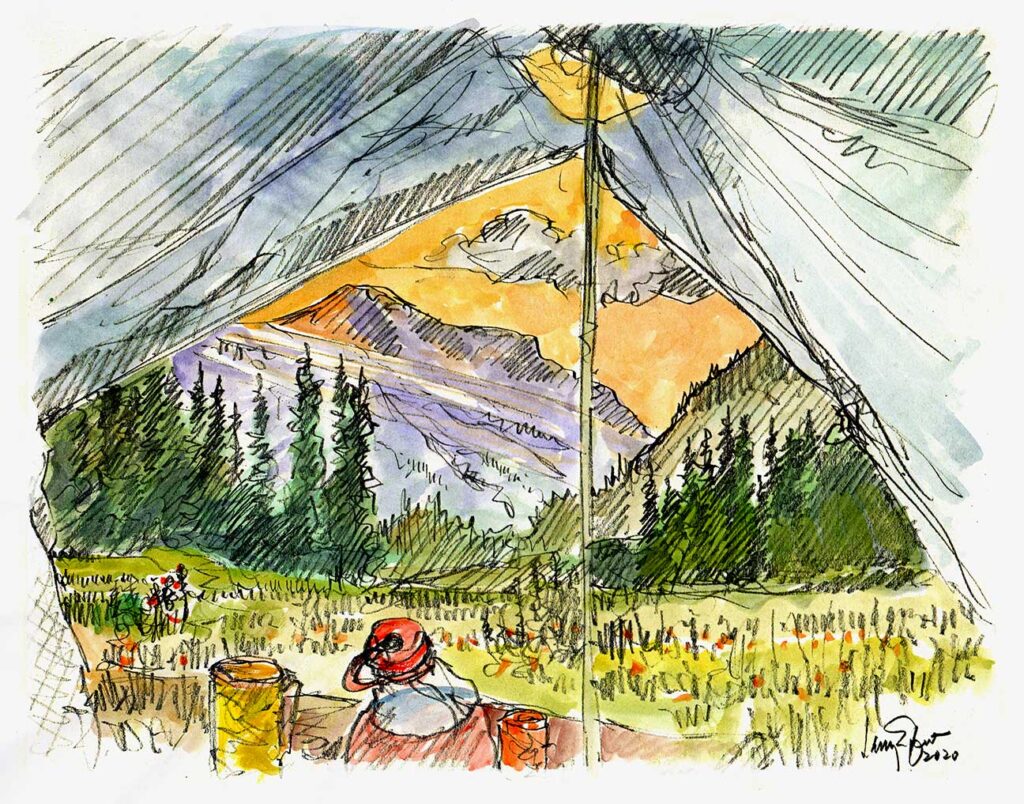In the 1970’s, I hiked into Caribou Lakes Basin in Northern California’s Trinity Alps. It’s a place of great beauty, stark white Sierra granite and rare plants that mix Pacific Coastal and Cascade ecosystems together in a jumbled profusion – the most conifer species together in one place in North America. That evening, I camped near another hiker, an older gentleman who was comfortably stretched out on a flat shelf of granite above the lake. (I was about 28 years old and everyone with white hair looked old to me.) It was a bit of a shock to realize he was without a tent or stove – or even a sleeping bag. I remember actually being a little worried about him, then realized he was traveling as light as one could in those days. He knew exactly what he was doing, much more than I did. After more consideration, I realized he wouldn’t have been there in the first place had he been carrying the normal 40+ lbs. we all struggled with in those days. A big smile was on his face, I remember that, and he looked to have less than half of 40 lbs. spread around him. No wonder he was smiling!
His main equipment seemed to be just a big tarp, and after his cold dinner he simple rolled everything, including himself, inside the tarp and spent the night poking his head out to star-watch, decades before Dark Skies became a ‘thing’ in Parks. I remember thinking he was like a big burrito, rolled in that tarp, and wondered if the bears liked Mexican. The next day, he told me he was in his 70’s and was determined not to stop hiking, experiencing pristine and untrammeled nature and that it kept him healthy.
Today, I am that guy!
The Addition of Art
Very early on I learned to carry paper and pencil, watercolors and brushes into the wild. Little paintings that became the result piled up at home – so I started selling them, and all these years later I can say I’ve actually made a good living painting nature. It takes thousands of paintings to become an artist, and, well, that’s just what I did, one little effort at a time. The ah-hah moment came in the 80’s when I realized I could make art in national parks, and park staff might find a place for them actually in the park.
As the decades passed, the outdoor gear companies caught up with me, and my tent, bag, stove and all the rest now weighs about as much as the older gent’s tarp – yes, the tent, bag, pack and all the rest weigh in at about 25 lbs, including the painting materials. What that means is that besides me, many more women and older hikers are out there now, and with some physical luck, I’ll bet you I can continue to do this into my 80’s. These days I don’t go as far, or as high, but still I get to meaningful and stunningly-wild places all the same.
So why go to all this trouble with the art-thing? Why go to wild country and take paper and pencil, maybe some paints. Wouldn’t it be easier just to pull out my phone and take pictures like everyone else? See it, point and tap. My short answer is, yes, of course it’s easier to take a photo. I do this too. But this art-thing is vastly beyond the level of hastily recording your journey. It’s not just about holding up a plastic box in front of you, shielding your eyes from what you might actually be seeing and looking into a little TV. It’s about YOU actually seeing what you’re looking at and seeing it better. A lot better!
When I make a little sketch, it takes some studying.
You don’t just bang it out and run down the trail, and that’s why most of these are either early morning or late afternoon paintings made around camp. Those contemplative times mean I can stand there and ask myself just how does that mountain ridgeline go? How are the trees in front of it highlighting certain areas of the mountains behind them? What about the foreground where there’s a little path, maybe that might be moved over a bit to make a better composition. In fact, maybe I can move the mountains a bit left to highlight some details I like. Oh, you sure can’t do THAT with your phone camera, can you? It’s a clear day, totally blue skies? Maybe I could add some clouds to make it more complex and interesting, just a few flicks of the pencil and I have mountains tearing at passing clouds, making movement and drama. You see, it’s not just about making art from what you see, it’s about designing nature to look even better than it is – and these places are fairly wonderful already.
I usually start these little paintings by just taking a moment – and looking, really looking at what I got all enthrawled with in the first place. What did I think might make it a nice piece of art? I try not to design the entire thing in my mind, just get a sense of what’s out there. Maybe it’s some fish swimming below me in a clear pool, a bird going about it’s business, the way two ridgelines come together. The painting above shows some of this, the way the two mountains lean inwards toward the picture’s center. Then the trail angles away and upwards towards the same spot. It’s a way to bring the wondering eyeballs towards the tent, the center-of-interest where you want viewers to end up. I wanted them to imagine that THEY, the viewers are walking up the trail towards camp.
American Dippers are one of my favorite creatures to paint. These little gray birds make their lives along only the clearest and coldest mountains streams, and even nest behind waterfalls where the little growing family is constantly wet, or very nearly so. Given a sharp elbow bend in the stream, they will always fly over water the long way instead of short-cutting it through forest. But here’s the best part. They make their living by walking and flying underwater, looking for insects, small fish and caddisfly larva. For me, an artist-naturalist, they hold fascination because of their homes, maybe more than the bird itself. In this painting, I carefully left the area behind the dipper so the dull-gray bird would stand out better on it’s perch rock. In reality, a second after I drew it, the bird jumped into the pool and vanished as it made it’s way in search of dinner. Yes, they dip up and down when rock-sitting.
That evening, I watched the colors of the setting sun high overhead and beyond the mountains. I had lost the sun an hour earlier down in this canyon, but had already picked out a ‘sitting rock’ for morning coffee, a Starbucks instant backpackers seem to prefer – me too. As I looked at the sky overhead, I noticed the silhouetted trees arched over the top of me. Of course, in reality they were actually straight vertical, but I made this painting look like they were arched over me, closing me in like a shelter. For clarity and design, I left out about half of them and focused on just two for details. Did I get the point across?
I should probably mention here that this year Six Moon Designs sponsor me by passing over some of their gear to try. I feel good that, at 74, I have such a company willing to help me continue my life of hiking, making it easier to get to these places. The painting below is their Lunar Solo, a beautiful little single-hiker tent that’s making these trips a joy. That’s a single pole holding it up. The entrance side can be opened wide for an 8-foot view, sort of like a picture window. I love to sit inside with both sides opened up. This evening I sat there and watched the sun set as I drew this painting almost to completion, adding my water jug, stove and coffee mug in the foreground to give it scale and a connection to me. Those things were placed there at the end once I sketched the rest of it. In front, the huge meadow allowed me to watch wildlife appear at the end of a hot day, but by the time the deer showed up, the painting was finished. Does it feel like you’re there ready to crawl into your sleeping bag? I hope so.
I truly believe that making simple expressions on paper can enhance a hike anywhere, and give you something solid to remember it with.
Thanks for reading this week. You can sign up for emails for these posts on my website at larryeifert.com.
Larry Eifert
Here’s my Facebook fan page. I post lots of other stuff there.
Click here to go to our main website – with jigsaw puzzles, prints, interpretive portfolios and lots of other stuff.
Nancy’s web portfolio of stunning photography and paintings.
And here to go to Virginia Eifert’s website.
